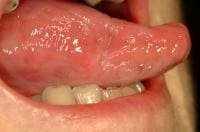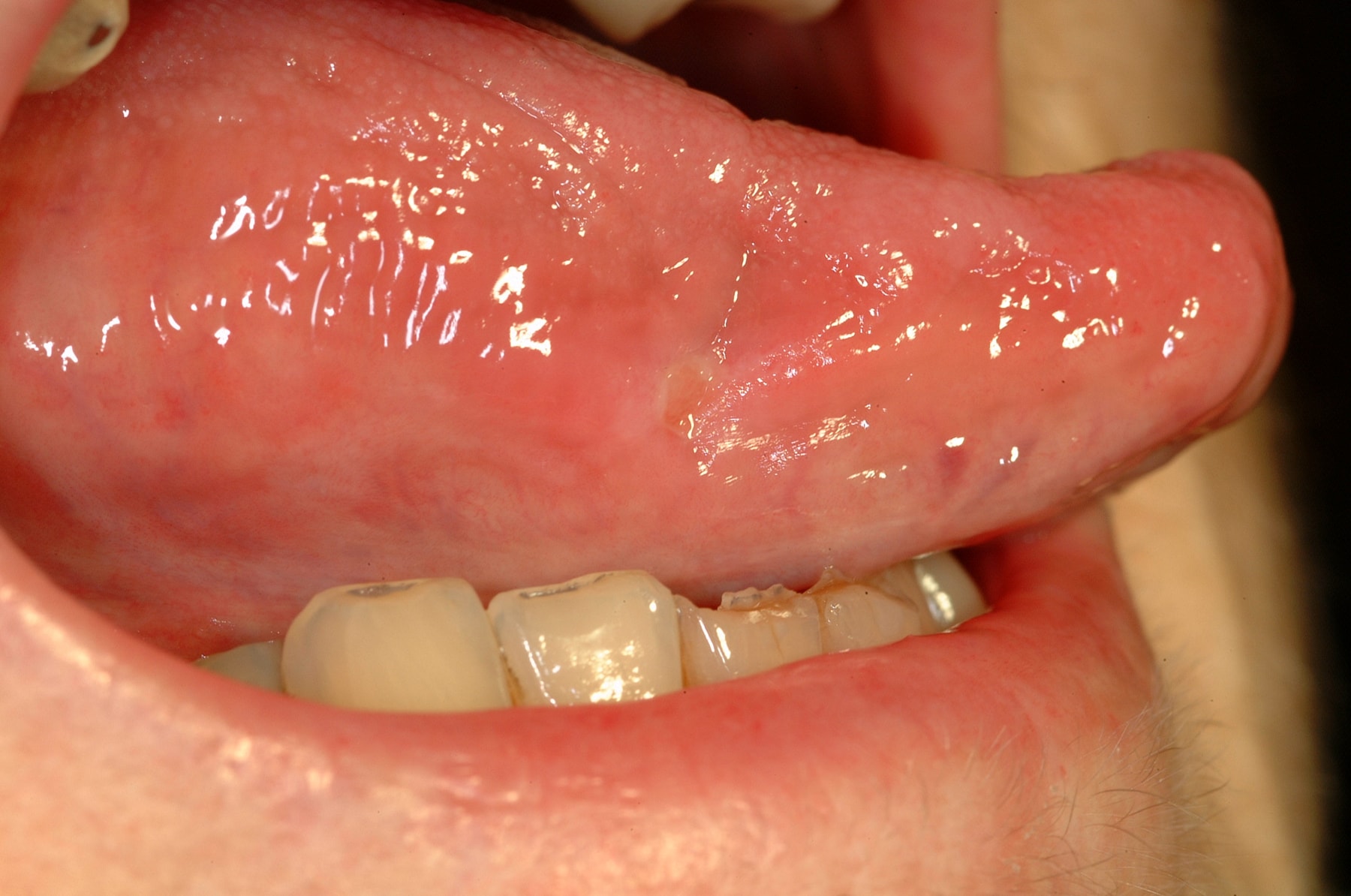Introduction
Background
Recurrent aphthous stomatitis (RAS) is a common condition, restricted to the mouth, that typically starts in childhood or adolescence as recurrent small, round, or ovoid ulcers with circumscribed margins, erythematous haloes, and yellow or gray floors. A positive family history of similar ulcers is common, and the natural history is typically of resolution in the third decade of life.
Ulcers with similar clinical features but rarely resolving spontaneously with age may be termed "aphthous-like ulcers," and may then be associated with systemic conditions such as Behçet syndrome, auto-inflammatory syndromes, gastrointestinal disease, or immune defects such as HIV/AIDS.
Pathophysiology
The etiology of recurrent aphthous stomatitis (RAS) is not entirely clear, and aphthae are therefore termed idiopathic. RAS may be the manifestation of a group of disorders of quite different etiology, rather than a single entity.
Despite many studies trying to identify a causal microorganism, RAS does not appear to be infectious, contagious, or sexually transmitted. Immune mechanisms appear at play in persons with a genetic predisposition to oral ulceration.
A genetic basis exists for some RAS. This is shown by a positive family history in about one third of patients with RAS, an increased frequency of HLA types A2, A11, B12, and DR2, and susceptibility to RAS which segregates in families in association with HLA haplotypes. RAS probably involves cell-mediated mechanisms, but the precise immunopathogenesis remains unclear. Phagocytic and cytotoxic T cells probably aid in destruction of oral epithelium that is directed and sustained by local cytokine release.
Patients with active RAS have an increased proportion of gamma-delta T cells compared with control subjects and patients with inactive RAS. Gamma-delta T cells may be involved in antibody-dependent cell-mediated cytotoxicity (ADCC). Compared with control subjects, individuals with RAS have raised serum levels of cytokines such as interleukin (IL)–6 and IL-2R, soluble intercellular adhesion modules (ICAM), vascular cell adhesion modules (VCAM), and E-selectin; however, some of these do not correlate with disease activity.
Cross-reactivity between a streptococcal 60- to 65-kd heat shock protein (hsp) and the oral mucosa has been demonstrated, and significantly elevated levels of serum antibodies to hsp are found in patients with RAS. Lymphocytes of patients with RAS have reactivity to a peptide of Mycobacterium tuberculosis. Some cross-reactivity exists between the 65-kd hsp and the 60-kd human mitochondrial hsp. Monoclonal antibodies to part of the 65-kd hsp of M tuberculosis react with Streptococcus sanguis. RAS thus may be a T cell–mediated response to antigens of S sanguis, which cross-react with the mitochondrial hsp and induce oral mucosal damage. RAS patients have an anomalous activity of the toll-like receptor TLR2 pathway that probably influences the stimulation of an abnormal Th1 immune response.
Predisposing factors found may include any of the following:
- Hematinic deficiency: Up to 20% of patients are deficient of iron, folic acid (folate), or vitamin B.
- Malabsorption in gastrointestinal disorders: About 3% of patients experience these disorders, particularly celiac disease (gluten-sensitive enteropathy) but, occasionally, Crohn disease, pernicious anemia, and dermatitis herpetiformis. HLA DRW10 and DQW1 may predispose patients with celiac disease to RAS.
- Cessation of smoking: This may precipitate or exacerbate RAS in some cases.
- Stress: This underlies RAS in some cases; ulcers appear to exacerbate during school or university examination times.
- Trauma: Biting of the mucosa and wearing of dental appliances may lead to some ulcers; RAS is uncommon on keratinized mucosae.
- Endocrine factors in some women: RAS is clearly related to the progestogen level fall in the luteal phase of the menstrual cycle, and ulcers may then temporarily regress in pregnancy.
- Allergies to food: Food allergies occasionally underlie RAS; the prevalence of atopy is high. Patients with aphthae may occasionally have a reaction to cow's milk, and may have been weaned at an early age.
- Sodium lauryl sulphate (SLS): This is a detergent in some oral healthcare products that may aggravate or produce oral ulceration.
- Immune deficiencies: Ulcers similar to RAS may be seen in patients with HIV, neutropenias and some other immune defects.
- Drugs, especially NSAIDs, alendronate, and nicorandil:1 These may produce lesions clinically similar to RAS.
Frequency
United States
RAS affects 5-66% of the population. Approximately 1% of children from higher socioeconomic groups in developed countries have RAS; however, 40% of selected groups of children can have a history of RAS, with ulceration beginning before age 5 years and with the frequency of affected patients increasing with age.
Mortality/Morbidity
Most patients with RAS are otherwise well.
Race
RAS have been reported in all races
Sex
A slight female predominance exists.
Age
RAS typically starts in childhood or adolescence.
Clinical
History
The 3 main clinical types of recurrent aphthous stomatitis (RAS) are as follows:
(1) Minor aphthous ulcers (MiAUs, 80% of all RAS)
(2) Major aphthous ulcers (MjAUs)
(3) Herpetiform ulcers.
However, any significance of these distinctions is unclear (ie, they could just be 3 distinct disorders). Diagnosis is based on history and clinical features.
Characteristics of MiAUs (ie, Mikulicz ulcers) include the following:
- They occur mainly in persons 10-40 years of age.
- They often cause minimal symptoms.
- They are small round or ovoid ulcers 2-4 mm in diameter. (MiAUs are round or ovoid in most situations but are often more linear when in the buccal sulcus, a common site.)
- They have an ulcer floor that is initially yellowish but assumes a gray hue as healing and epithelialization proceeds.
- They are surrounded by an erythematous halo and some edema.
- They are found mainly on the nonkeratinized mobile mucosa of the lips, cheeks, floor of the mouth, sulci, or ventrum of the tongue; they are uncommonly seen on the keratinized mucosa of the palate or dorsum of the tongue.
- They occur in groups of only a few ulcers (ie, 1-6) at a time.
- They heal in 7-10 days.
- They recur at intervals of 1-4 months.
- They leave little or no evidence of scarring.
Characteristics of MjAUs (ie, Sutton ulcers, periadenitis mucosa necrotica recurrens [PMNR]) include the following:
- They are larger, of longer duration, of more frequent recurrence, and often more painful than MjAUs.
- They are round or ovoid like MjAUs but are larger and associated with surrounding edema.
- They reach a large size, usually about 1 cm in diameter or even larger.
- They are found on any area of the oral mucosa, including the keratinized dorsum of the tongue or palate.
- They occur in groups of only a few ulcers (ie, 1-6) at one time.
- They heal slowly over 10-40 days.
- They recur extremely frequently.
- They may heal with scarring.
- They occasionally are found with a raised erythrocyte sedimentation rate or plasma viscosity.
Characteristics of herpetiform ulceration (HU) include the following:
- They are found in a slightly older age group than the other RAS.
- They are mainly found in females.
- They begins with vesiculation that passes rapidly into multiple, minute, pinhead-sized, discrete ulcers.
- They involve any oral site, including the keratinized mucosa, increase in size, and coalesce to leave large round ragged ulcers.
- They heal in 10 days or longer.
- They are often extremely painful.
- They recur so frequently that ulceration may be virtually continuous.
Most patients appear to be otherwise well, but a minority have etiologic factors that can be identified by the history. These factors may include the following:
- Dentifrices containing sodium lauryl sulfate
- Trauma
- Stress
- Cessation of smoking
- Menstrual cycle association
- Food allergy
Aphthous-like ulcers may appear in the following diseases and states:
- Hematinic deficiency (eg, iron, folate, vitamin B-12)
- Celiac disease
- Crohn disease
- Behçet syndrome, which may include genital, cutaneous, ocular, or other lesions (The mouth ulcers in Behçet syndrome are often major aphthae, with frequent episodes and long duration to healing.)
- Immunodeficiencies such as human immunodeficiency virus (HIV) infection, and neutropenia (Ulcers appearing on a regular 3-week cycle may indicate cyclic neutropenia.)
- Auto-inflammatory syndromes, such as periodic fever, aphthous stomatitis, pharyngitis, and cervical adenitis syndrome (PFAPA) in children
- Malignancy (Ulcers appearing for the first time in an older individual may reflect underlying systemic disease [eg, colonic carcinoma with chronic hemorrhage].)
- Drug use (eg, nicorandil, NSAIDs, others)
- Sweet syndrome, a rare immunologically mediated condition that belongs to the group of neutrophilic dermatoses and must be differentiated, particularly from Behçet disease
- Sweet syndrome is characterized by red-brown plaques and nodules that are frequently painful and occur primarily on the head, neck, and upper extremities.
- Patients often also have neutrophilia and fever and may have oral ulceration.
Physical
RAS ulcers are recurrent small, round, or ovoid ulcers with circumscribed margins, erythematous haloes, and yellow or gray floors. No specific investigations exist for RAS.
Causes
Some RAS cases involve a familial and genetic basis; approximately 40% of patients with RAS have a familial history, but inheritance may be polygenic with penetrance dependent on other factors.
- Most relevant studies have found hematinic (eg, iron, folic acid, vitamin B-12) deficiencies in as many as 20% of patients with recurrent ulcers. In addition, deficiencies of vitamins B-1, B-2, and B-6 have been noted in some patient cohorts.
- The previously proposed association between recurrent ulcers and celiac disease (gluten-sensitive enteropathy [GSE]) is tenuous, despite some evidence that the haplotype of HLA-DRW 10 and DQW1 may predispose patients with GSE to RAS.
- Hypersensitivity reactions to exogenous antigens other than gluten do not have a significant etiologic role in RAS, and associations with atopy are inconsistent.
- Local physical trauma may initiate ulcers in susceptible people, and RAS is uncommon where mucosal keratinization is present or in patients who smoke tobacco.
- A consistent association between aphthouslike ulceration and psychological illness, zinc deficiency, or sex hormone levels is unlikely.
- Various microorganisms have been examined for a causal association. Latterly, Helicobacter pylori has been detected in lesional tissue of ill-defined oral ulcers, but the frequency of serum immunoglobin G (IgG) antibodies to H pylori is not increased in RAS. Little evidence suggests an etiologic association between viruses and RAS. Human herpesviruses (HHV)–6 and HHV-7 DNA have not been demonstrated in RAS, but HHV-8 DNA is present in HIV-related oral ulcers.



I was diagnose with genital warts since 2012 i have be taking lot treatment and all i got is outbreak. in 2015 I gave up the treatment because I can't continues wasting time and money on treatment at the end it will not cure me. about 6 weeks ago i did natural research online I had So many people talking good about natural remedy, after the research i was recommended to Dr onokun, And I wrote to him through his email and told him my problem after some conversations with him he gave me natural treatment after 1 week Dr onokun treated me i got cured permanently. and i went to see my doc he confirmed that the diseases has gone out from my body. every patients should know there is 100% natural hpv cure. contact Dr onokun his email address: dronokunherbalcure@gmail.com
Trả lờiXóa